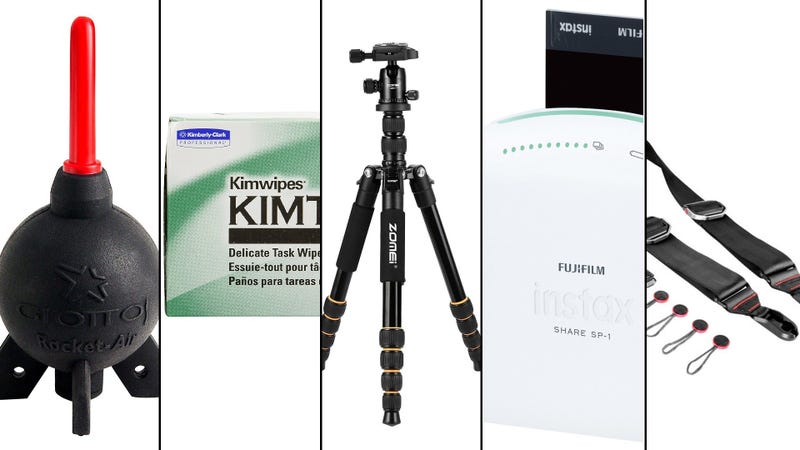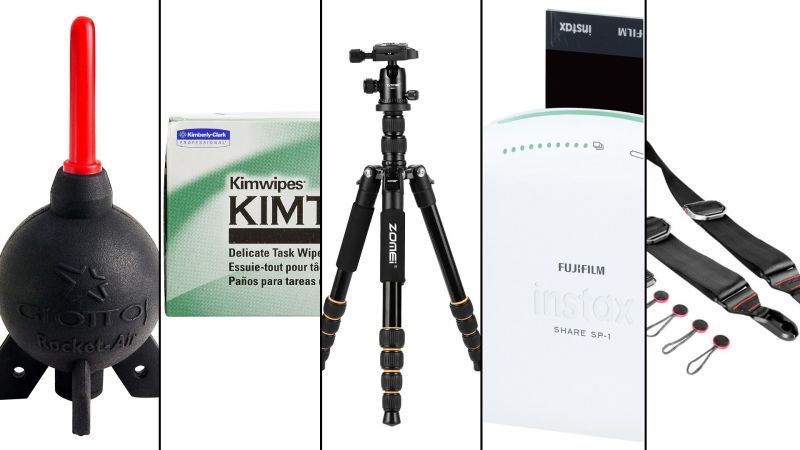
There’s more to a travel photographer’s kit than a camera body and a few lenses. Here are the essentials the pros always keep close at hand.
I recently took a trip to Cuba with some professional photographers, filmmakers, and travel influencers to learn the ins and outs of capturing the world on (digital) film (full disclosure: this trip was paid for by Adobe). While we toured the colorful streets of Havana and navigated the luscious countryside of Viñales, I asked the pros to show me the inside of their bags in between shooting sessions.
Renan Ozturk (@renan_ozturk), a photographer and filmmaker for National Geographic, Elisabeth Brentano (@elisabethontheroad), a professional landscape photographer, and a few other experienced travelers were gracious enough to show me everything they carried with them. Here’s a quick rundown:
- Air blower (mini-blimp or mini-rocket): A brilliant little device you squeeze to shoot out blasts of air. Perfect for cleaning dust and debris off your camera lenses and sensitive electronics. You can get one of Giotto’s blasters for about $10.
- Microfiber lens wipes: Microfiber cloths work well enough, but they absorb oils, dirty water, and pick up all that dust you’re cleaning off your gear. Disposable microfiber wipes like Kimwipes (box of 280 for $10) solve that problem. Plus, you can tear off a couple for your bag and put some in your pocket.
- Etip gloves: If you’re shooting somewhere cold and you’re shooting on your phone, or have any other touchscreen devices, these are a must. They also provide pretty good finger articulation, which is nice while you’re shooting photos. You can grab a nice pair from The North Face for around $30.
- Pocket hand warmers: These keep your hands warm, yes, but you can also use them to keep your extra camera batteries warm so they don’t die before you can use them. Also works well for keeping your phone from dying when it’s freezing out. The popular Hot Hands kind cost about $7 for 10 packs.
- Flip-flops: Sometimes your excursions go from dry land to water, and it’s a good idea to keep your socks and shoes dry. Thin, easy to pack, and super cheap to boot (most pairs are less than $10)
- Sunglasses: Ozturk says sunglasses are like neutral density filters for your eyes. You invest in good glass for your camera, so why wouldn’t do the same for your eyes? You kind of need them for photography after all.
- Lightweight tripod: Ozturk’s preferred tripod is a carbon fiber model, while Brentano’s was an aluminum alloy model. Both super light, but these can be pretty expensive (like upwards of $200). This ZOMEI Aluminum Portable Tripod ($75) isn’t a bad option, though.
- Socks: Always wear some nice socks, preferably synthetic or wool. In fact, Ozturk wears ski socks. They don’t get stinky as fast as cotton socks, and they last forever. You can buy a pair of Wigwam performance ski socks for less than $20.
- Rain gear: A lightweight rain poncho or rain jacket ($11 – $20) will keep you and your gear dry. Not a bad idea to pick up a camera rain cover too ($15).
- Filters: Neutral density filters for shooting waterfalls beaches and other waterscapes, and a polarizing filter for shooting brightly lit skies and lakes.
- Nice camera strap: I was shown this nifty camera strap from Peak Design ($60) and I bought one as soon as I got back in the states. Super sturdy, but cameras can clip on and off the strap in a snap.
- Mini photo printer: The Fujifilm Instax Smartphone printer ($160) is a nifty gadget, but Josh Haftel, the Adobe Photoshop Lightroom mobile product manager, showed me it has an excellent hidden use for travel photogs. You can give recently-shot photos to people in exchange for taking their photo instead of money tips. It’s especially great for kids when you want to give out gifts.
- Tablet and SD card dongle: Ozturk likes to edit his photos on the go (bus, train, plane, hotel lobbies, at dinner), using Lightroom Mobile on an iPad Pro. iPads are lighter than laptops, have just as much power (or at least as much as you need for photo edits), are super thin, have more screen real estate than a smartphone, and you can import RAW images for editing with an SD card dongle. I was so impressed with his workflow, I bought a used iPad Pro and adopted the same setup.
Of course, there are a lot of other essentials you’d expect as well. Things like extra camera batteries, extra memory cards (stored in a plastic bag, not a carrying case), snacks (jerky, energy bars, etc.), lotion, sunscreen, chapstick, a hat that provides adequate shade, a portable charger (a solar-powered one if you’ll be in a sunny place), and maybe an extra camera body as a backup if you’re traveling to a place where camera repair won’t be possible.
Whatever you pack in your own travel photography bags, Ozturk and Brentano both suggest you keep it as light as possible. See the best sites around the world often means a ton of walking, hiking, backpacking, and possibly even climbing. They stick to mid-range camera bags, which, when full, weigh around 25 pounds tops. But if they need to go super lightweight, they get their bags down to 5 to 10 pounds, so keep that in mind when you start packing. In general, Ozturk recommends you ditch the original packaging and bulky cases—like memory card or battery cases—whenever you can. Pare down, carry less, and carry thin.
















